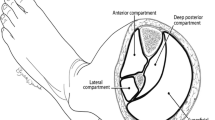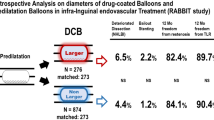Abstract
Repair of occult arterial injuries is advocated to prevent thrombosis, arteriovenous fistula, and pseudoaneurysm formation. However, recent clinical series describe the healing of arterial intimal injuries and recommend nonoperative therapy. To investigate the arterial wall response to intimal injury, we created intimal flaps in 46 canine femoral arteries. The intimal flaps were imaged by arteriography, angioscopy, and intravascular ultrasound acutely, and at one and three weeks and five months post-injury. Lumen area was measured using caliper techniques (arteriography) and computerized video planimetry (angioscopy, intravascular ultrasound). Intimal and medial thickness were measured by intravascular ultrasound prior to harvest for histologic evaluation by light microscopy. Analysis of 32 patent arteries was performed after exclusion of 14 thrombosed arteries. Residual lumen area (mm2) correlated closely among the imaging modalities at one week (8.7±1.1, 7.3±2.0, 6.9±1.8), three weeks (4.2±0.9, 2.9±1.0, 2.7±0.8), and five months (5.3±0.9, 5.0±0.5, 5.0±0.9). Maximal intimal and medial thickness occurred three weeks post-injury, coincident with the maximal reduction in lumen area. Although intimal injuries can cause acute and delayed arterial thromboses, observation may be appropriate in selected cases. The evaluation of those patients chosen for nonoperative therapy should extend beyond three weeks, as this is the time of maximal arterial wall response with a continued potential for adverse clinical events.
Similar content being viewed by others
References
PERRY MO, THAL ER, SHIRES GT. Management of arterial injuries.Ann Surg 1971;173:403–408.
RICH NM, SPENCER FC.Vascular Trauma. Philadelphia: W.B. Saunders, 1978, pp 39–43.
FRYKBERG ER, VINES FS, ALEXANDER RH. The natural history of clinically occult arterial injuries: a prospective evaluation.J Trauma 1989;29:577–583.
STAIN SC, YELLIN AE, WEAVER FA, et al. Selective management of nonocclusive arterial injuries.Arch Surg 1989;124:1136–1141.
RICH NM, HOBSON RW, COLLINS GJ. Traumatic arteriovenous fistulas and false aneurysms: a review of 558 lesions.Surgery 1975;78:817–828.
FELICIANO DV, CRUSE PA, BURCH JM, et al. Delayed diagnosis of arterial injuries.Am J Surg 1987;154:579–584.
NEVILLE RF, HOBSON RW, WATANABE B, et al. A prospective evaluation of arterial intimal injuries in an experimental model.J Trauma 1991;31(5):669–675.
BARTORELLI AN, POTKIN BN, ALMOGOR Y, et al. Intravascular ultrasound imaging of atherosclerotic coronary arteries: an in vivo validation study.J Am Coll Cardiol 1989;2:54A.
NEVILLE RF, BARTORELLI AN, SIDWAY AN, et al. An in vivo feasibility study of intravascular ultrasound imaging.Am J Surg 1989;158:142–145.
NEVILLE RF, HOBSON RW, JAMIL Z, et al. Intravascular ultrasonography: validation studies and preliminary intraoperative observations.J Vasc Surg 1991;13(2):274–283.
ANDERSON RJ, HOBSON RW, PADBERG FT, et al. Penetrating extremity trauma: identification of patients at high-risk requiring arteriography.J Vasc Surg 1990;12:544–548.
GEUDER JW, HOBSON RW, PADBERG FT, et al. Role of contrast arteriography in suspected arterial injuries of the extremities.Am Surg 1985;51:89–93.
ANDERSON RJ, HOBSON RW, LEE B, et al. Reduced dependency on arteriography for penetrating extremity trauma with influence of wound location and noninvasive vascular studies.J Trauma 1990;30:1059–1063.
ROSE SC, MOORE EE. Angiography in patients with arterial trauma: correlation between angiographic abnormalities, operative findings, and clinical outcome.Am J Roentgenol 1987;149:613–619.
CLOWES AW, REIDY MA, CLOWES MM. Mechanisms of stenosis after arterial injury.Lab Invest 1983;49(2):208–215.
WALKER LN, RAMSAY MM, BOWYER DE. Endothelial healing following defined injury to rabbit aorta.Atherosclerosis 1983;47:123–130.
CLOWES AW, CLOWES MM, REIDY MA. Kinetics of cellular proliferation after arterial injury.Lab Invest 1986;54(3):295–303.
SAWCHUCK AP, ELRUP-JORGENSEN J, TOBER J, et al. The natural history of intimal flaps.Arch Surg 1990;125:1614–1616.
Author information
Authors and Affiliations
About this article
Cite this article
Neville, R.F., Padberg, F.T., DeFouw, D. et al. The arterial wall response to intimal injury in an experimental model. Annals of Vascular Surgery 6, 50–54 (1992). https://doi.org/10.1007/BF02000668
Issue Date:
DOI: https://doi.org/10.1007/BF02000668




